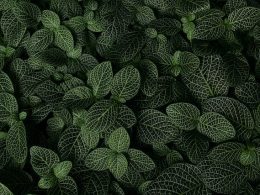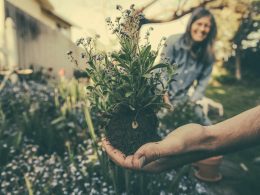Do you love spending time outdoors surrounded by lush greenery and blooming flowers? If so, why not make your garden a little greener? Going green in your outdoor space is not only beneficial for the environment but also for your health. By making environmentally conscious choices, you can create a beautiful and sustainable garden that will thrive for years to come. In this blog post, we’ll explore some ideas on how to go green in the garden from starting out to choosing the right plants and fertilizers. So let’s get started!
Starting Your Garden from Scratch
Starting a garden from scratch can be both exciting and intimidating. To begin, choose an area in your yard that has plenty of sunlight and good soil drainage. It’s also important to take into account the size of your garden and what you want to grow.
Once you’ve selected your spot, it’s time to prepare the soil for planting. Start by removing any weeds or debris from the area. Next, loosen up the soil with a shovel or tiller so that it is easy to work with.
Before planting anything, consider adding compost or other organic matter to your soil. This will help improve its structure and provide essential nutrients for plant growth.
When deciding what plants to include in your new garden, think about what grows well in your region as well as what you enjoy eating or looking at. Do some research on which vegetables and flowers thrive in local climates.
Don’t forget about maintenance! A successful garden requires ongoing care such as watering regularly and pruning when necessary. With these tips in mind, starting a garden from scratch can be a rewarding experience that yields beautiful results year after year.
Planning Your Garden Layout
Planning Your Garden Layout
One of the most crucial aspects of creating an environmentally conscious outdoor space is planning your garden layout. A well-planned garden not only looks beautiful but also helps in maximizing plant growth and yields.
Start by observing the sunlight patterns in your yard to determine where you want to place your plants. Vegetables typically require six hours or more of direct sunlight, while flowers may need less.
Next, consider the soil type and moisture level in different areas of your yard. Some plants thrive in moist soil, while others prefer drier conditions.
When designing your garden layout, think about grouping plants according to their water needs and sun exposure requirements. This makes it easier for you to water them efficiently using a drip irrigation system or rainwater harvesting techniques.
Additionally, incorporating companion planting techniques can help reduce pests and diseases naturally without resorting to harmful chemicals that harm beneficial insects like bees and butterflies.
By carefully planning your garden layout, you can create an outdoor space that is both aesthetically pleasing and ecologically sustainable!
Choosing the Right Vegetables and Flowers for Your Garden
When it comes to choosing the right vegetables and flowers for your garden, there are a few things to consider. First, think about the climate you live in and what will grow well in that environment. If you’re unsure, do some research or talk to a local gardening expert.
Next, consider your personal preferences. Do you want colorful flowers or practical vegetables? Both can be beautiful additions to any garden.
When selecting vegetables, think about which ones are easy to grow and maintain. Tomatoes and peppers are popular choices for beginners because they don’t require much attention and produce tasty results.
If you’re interested in growing fruits, strawberries and blueberries are great options as they can be grown easily in pots or raised beds.
As for flowers, sunflowers add height and vibrancy while marigolds can help deter pests from eating your veggies!
Ultimately, choose plants that bring joy to both yourself and the environment. By selecting plants that thrive naturally in your area with minimal intervention needed on your part – aside from regular watering of course – is one way towards creating an environmentally conscious outdoor space!
Fertilizing and Watering Your Garden
Fertilizing and watering your garden are two of the most critical aspects of gardening. Fertilizer provides essential nutrients for plant growth, while water is necessary to keep plants hydrated.
When it comes to fertilizing your garden, there are a few things you should keep in mind. First, consider using organic fertilizers instead of synthetic ones. Organic fertilizers release nutrients slowly over time and promote healthy soil structure, which can help prevent erosion and runoff.
Secondly, always follow the instructions on the fertilizer package carefully to avoid over-fertilization or damaging your plants’ roots. Over-fertilization can lead to nutrient burn or even death of your plants.
In terms of watering your garden, it’s important to find a balance between underwatering and overwatering. Underwatering can cause wilting and stunted growth in plants, while overwatering can lead to root rot or fungal diseases.
To ensure proper hydration for your plants, try to water them deeply once a week rather than shallowly every day. Also, consider using drip irrigation systems or soaker hoses as they provide consistent moisture without wasting water through evaporation.
By keeping these tips in mind when fertilizing and watering your garden, you’ll be well on your way towards creating an environmentally conscious outdoor space that thrives with life!
Conclusion
Creating an environmentally conscious outdoor space is not only good for the planet but can also be a rewarding and enjoyable experience. Starting from scratch, planning your garden layout, choosing the right plants, and fertilizing and watering properly are all important steps in cultivating a sustainable garden.
By incorporating green practices such as composting, using organic materials, and conserving water, you can further reduce your environmental impact while enjoying the benefits of fresh produce and beautiful flowers.
So why not take the step towards creating a more eco-friendly outdoor space? Small changes made in our own backyards can have a big impact on our environment. Let’s start today by planting our gardens with sustainability in mind!











